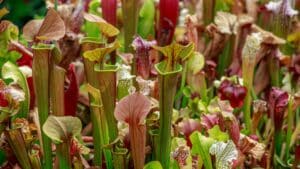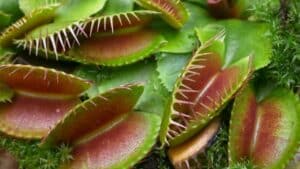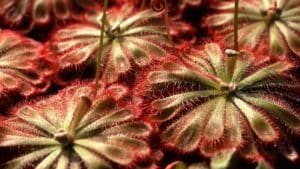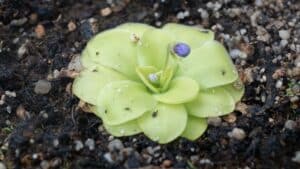
Carnivous Plant Varieties
Carnivorous plants are fascinating organisms that have evolved to capture and digest small animals in order to supplement their nutrient intake. Here are a few varieties of carnivorous plants:

2. Pitcher Plant (Sarracenia): Pitcher plants have specialized leaves that form long, tubular structures known as pitchers. These pitchers are filled with digestive fluids, attracting and trapping insects. There are 10 native North American species of pitcher plants in the genus Sarracenia. There are approximately 140 species of pitcher plants in the genus Nepenthese native to Australia, Madagascar, and Southeast Asia.
3. Sundew (Drosera): Sundews have leaves covered in sticky, glandular hairs that capture and digest small prey, typically insects. The hairs also produce enzymes to aid in digestion. There are approximately 194 species of sundews worldwide with about half their diversity being in Australia and less than 20 in North America.
4. Bladderwort (Utricularia): There are both terrestrial and aquatic species of Bladderwort carnivorous plants. They have bladder-like structures that suck in and trap small aquatic organisms, such as algae and protozoa. Bladdeworts are the largest species of carnivorous plants with an estimated 230 species distributed worldwide with the exception of
Antartica.
5. Cobra Lily (Darlingtonia californica): The Cobra Lily has a unique pitcher-like structure with a hood that resembles a cobra’s head. Insects are lured in and trapped by the downward-pointing hairs within the pitcher. Cobra lilies are one of the three genera of the pitcher plant family Sarraceniaceae. Cobra lilies are native to Northern California and Oregon.
6. Butterwort (Pinguicula): Butterwort carnivorous plants have sticky leaves that trap insects. The sticky secretions on the leaves contain enzymes that aid in digestion. There are approximately 80 species of butterworts distributed throughout the world with the exception of Australia.

These are just a few examples of the many fascinating varieties of carnivorous plants found in different habitats around the world.
Carnivorous Plant Care pdf download
From our office in Atlantic Beach and satellites throughout Northeast Florida, Rockaway Inc proudly serves both commercial and residential landscape design, maintenance, lawn care, irrigation, and outdoor living carpentry client needs in Jacksonville, St Augustine, Atlantic Beach, Neptune Beach, Jacksonville Beach, Ponte Vedra, Nocatee, St. Johns, and Fernandina Beach.
